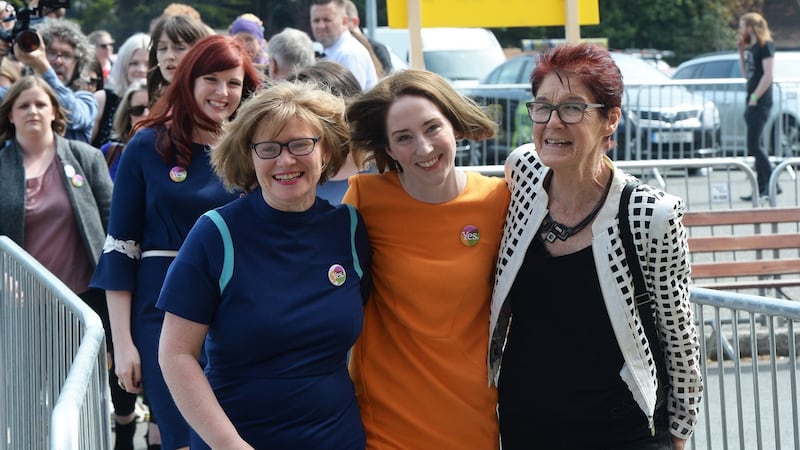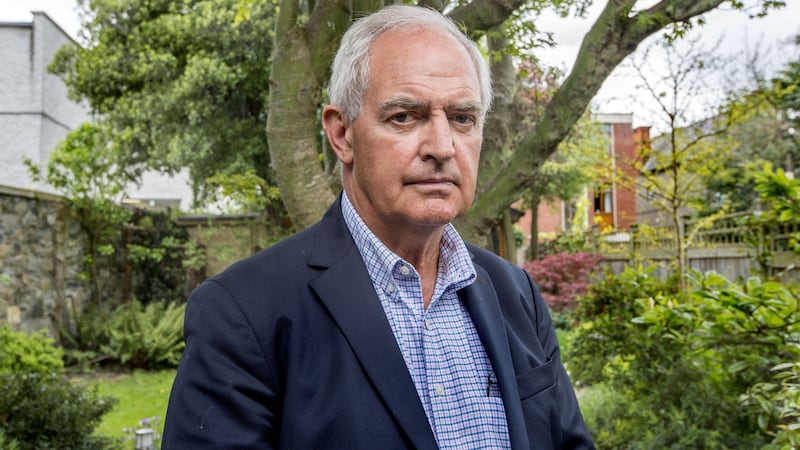It's a Yes! How Together for Yes Repealed the Eighth and Transformed Irish Society by Gráinne Griffin, Orla O'Connor and Ailbhe Smyth, with Alison O'Connor (Orpen Press, 220pp, €15)
In the Shadow of the Eighth by Peter Boylan (Penguin Ireland, 288pp, £14.99)
Ireland has changed a great deal since 1983, when the country voted overwhelmingly to insert the Eighth Amendment into the Constitution. The calls to ban abortion came from religious conservatives worried that Roe v Wade and Ireland’s membership in the European Union might have a liberalising affect on this country.
It was at this time that academic and activist Ailbhe Smyth became involved in pro-choice politics. Smyth, who founded the Women’s Studies Centre at University College Dublin, says speaking about abortion was difficult during the bleak recession days following the referendum, for feminists and non-feminists alike.
In It’s a Yes! she writes: “To be pro-choice, without even mentioning the word ‘abortion’, was to be a pariah in Irish society. Ultimately abortion has been the most difficult for feminism and the women’s movement and women in this country.” These challenges were to remain for many years.
With a strong attention to detail, It’s a Yes! charts the seismic social and political events affecting women’s access to abortion care that took place between that first referendum in 1983 and the second one on May 25th, 2018, when the people of Ireland voted overwhelmingly to repeal the Eighth Amendment.
The book chronicles landmark court cases, the introduction of the Protection of Life During Pregnancy Act, the work of the Citizens Assembly and, of course, the tragic death in October 2012 of Savita Halappanavar, who symbolised for so many the devastation caused by the Eighth Amendment.

All these events intensified public calls for a referendum on the abortion issue. On March 28th, 2018, Minister for Health Simon Harris, for whom Halappanavar’s death had acted as a clarion call, announced that a vote would be held on May 25th.
This book tells the remarkable story of how, as the people and politicians of the country moved closer to a referendum, women-led organisations – which ultimately formed the Together for Yes campaign – advocated tirelessly for reproductive healthcare rights.
As part of this, it interweaves the fascinating inside story of Together for Yes, the hugely successful national referendum campaign that forever changed Irish society. The story is told through the words of the three remarkable women who led the Together for Yes campaign, including Smyth, co-founder of the Coalition to Repeal the Eighth Amendment, as well as Orla O’Connor, director of the National Women’s Council, and Gráinne Griffin, a founding member of the Abortion Rights Campaign.
The significance of their work is recognised throughout Ireland, where women now have access to abortion care without having to travel abroad. It is also acknowledged within the international community, evidenced by the fact that these three women were each recognised as one of Time’s 100 Most Influential People in 2019 for their tireless work on Together for Yes.
Crucial to the success of the campaign was a focus on women’s personal experiences and a respect for those who wanted change but had felt polarised by arguments from entrenched anti-abortion and pro-choice activists. Also important to its success was its use of language, and moving the conversation about abortion from within a context of rights to that of healthcare.
Reflecting on how this approach helped bring about success, O’Connor writes: “The one thing that was clear is the importance of that personal story in convincing people of the need for change … if you can talk about really difficult issues in a way that speaks to the values of people and the compassionate part of people...then you have a really good chance of succeeding.”
This book represents an important historical text, documenting events that led to women’s access to abortion care. It is also a useful how-to guide for advocates, activists and politicians who wish to lead a successful campaign.
Inclusivity is a crucial value for many women-led organisations, and others who worked to repeal the Eighth Amendment are also mentioned in this book.
Personal and political
One person who found himself increasingly involved in the campaign was obstetrician Peter Boylan, who has just published a new book, In the Shadow of the Eighth.
In 1983, Boylan was working around the clock as a registrar and assistant master at the National Maternity Hospital on Holles Street. Busy with ward rounds, clinics and teaching, the referendum largely passed him by. Looking back, he now finds this ironic, given the central role Article 40.3.3 played in his life.
Like so many issues regarding childbirth and reproduction, this book is both personal and political, outlining Dr Boylan’s illustrious career as a consultant obstetrician and gynaecologist, which saw him serve as master of the National Maternity Hospital (NMH), and as chairman of the Institute of Obstetricians and Gynaecologists.
It is also a coming of age story, beginning with a young, enthusiastic doctor working in Ireland in the 1970s where, he writes, “contraception was illegal, tubal ligation was unheard of and no one discussed abortion”.

But inextricably linked to this personal narrative is a very important, detailed history of recent events that have utterly changed Ireland’s social and political landscapes, paving the way for significant improvements in women’s access to healthcare.
Boylan poignantly begins the book – as a reminder of how far Ireland has come – with a memory from 1973, when he was a student doctor doing a routine eight-week rotation in obstetrics, at Holles Street. There, one of the labour wards was designated solely for unmarried mothers, who came from mother and baby homes and Magdalene laundries. At the time, neither he nor his colleagues questioned this segregation.
Having attended the UCD School of Medicine, Boylan qualified as a doctor in 1974, and began working at St Vincent’s Hospital, an entity that would later play a major role in his own life and that of the NMH.
After working abroad, Boylan returned “home” to Holles Street for good in 1988, as the director of the foetal assessment unit, where high-risk pregnancies were supervised. He became master in 1991, a seven-year post, with a view to modernise the hospital and its services.
Because of his expertise in foetal medicine, Boylan was asked to give evidence in a number of court cases, including the inquest into the death of 31-year-old Savita Halappanavar. Boylan writes: “Her death shone a light on the malign influence of the Eighth Amendment … Ultimately, the presence of the Eighth Amendment cost Savita her life.”
Following her inquest, in April 2013, Boylan became increasingly determined to work towards eradicating the Eighth Amendment, which “had poisoned the practice of obstetrics in Ireland and was harming women. Irish women were not equal citizens of their own country while the shadow of the Eighth fell over them”. In 2018, he became involved in Together for Yes, criss-crossing the country on behalf of the campaign.
Boylan writes that his goal in writing this book is to highlight just how out of step Ireland was with the international community in regard to women’s healthcare, well into the 21st century. But as the debate regarding control of the new National Maternity Hospital at St Vincent’s hospital continues, and as termination services remain in development, Boylan reminds us there is no room for complacency in the fight for women’s reproductive rights.

















